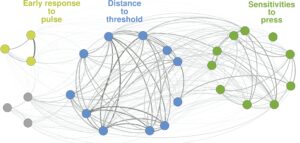Unveiling dimensions of stability in complex ecological networks
 Understanding what determines the stability of ecological communities is one of the oldest questions asked in ecology, an issue that has become even more pressing in the current context of global change. However, how can we define the stability of anything as complex as an ecological community? And how can we best measure stability?
Understanding what determines the stability of ecological communities is one of the oldest questions asked in ecology, an issue that has become even more pressing in the current context of global change. However, how can we define the stability of anything as complex as an ecological community? And how can we best measure stability?
Many metrics have been used for measuring ecological stability. For example, metrics quantify temporal variability, meaning to what extent the biomass or number of individuals of a species is variable over time. Others measure the time it takes for the community to return to its original state after a disturbance. Some metrics involve ‘robustness’, which quantifies the consequences of a species’ extinction on the rest of the community, or the maximum disruption a community could endure before it collapses. This diversity of metrics raises fundamental questions: do they all quantify the same thing? In other words, how are all these different metrics related with each other? If all metrics are strongly correlated to each other, it means that they are measuring the same thing and therefore stability can be estimated in different ways but the choice of metric does not matter. Otherwise, this means that stability is not a single concept, but can be broken down into different subsets (or ‘dimensions’) that remain to be identified.
In our recent piece in PNAS (early online), we attempt to answer this fundamental question. By using computer simulations, we quantify the stability of food web communities (where species are connected to each other feeding interactions) with 27 different metrics commonly used in the ecological literature. By studying the interdependence between the 27 stability metrics, we found that ecological stability can be broken down into 3 groups of metrics, or 3 ‘dimensions’. Within each of these groups, the metrics are redundant with each other, but between groups the metrics are independent and therefore contain different information. Measuring the overall stability of an ecological system requires measuring at least one metric from each of these 3 groups.